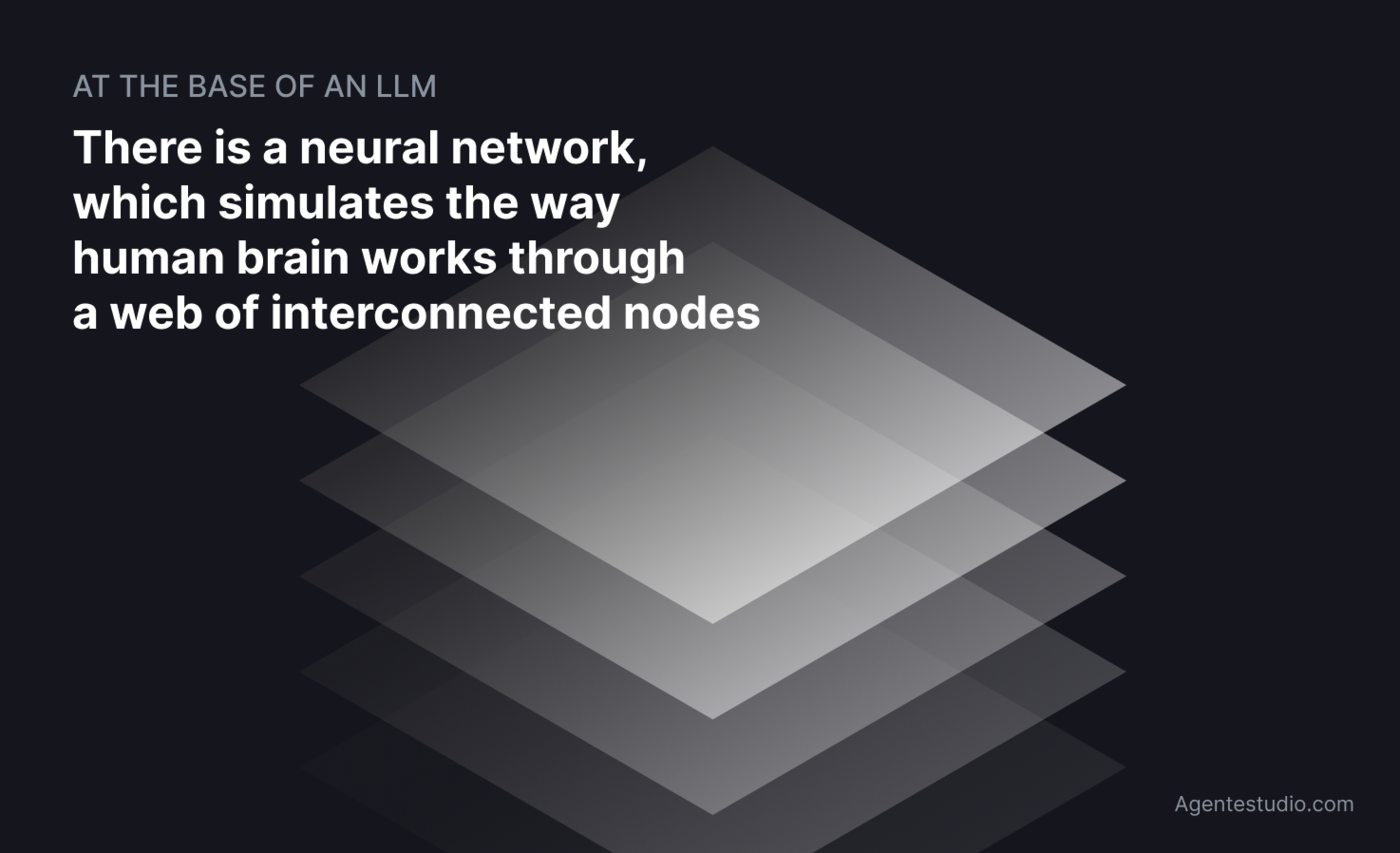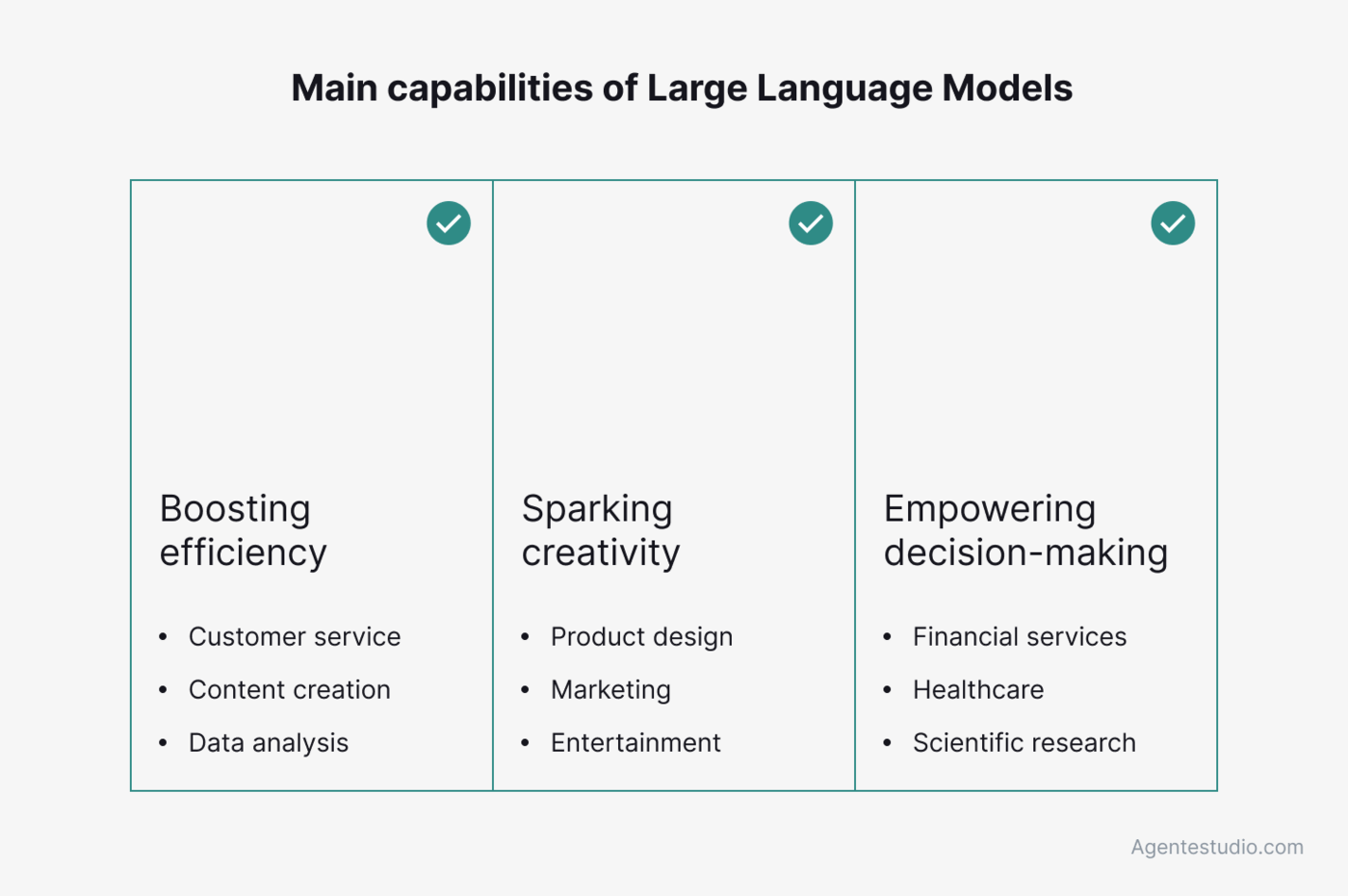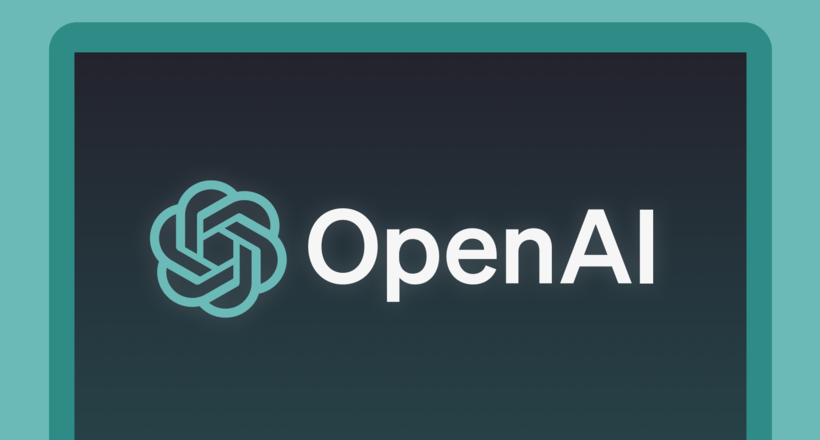
AI development is evolving at a quick pace, and recently we were introduced to the revolution in this transformative technology: large language models. But beyond the mere novelty, LLMs possess the potential to revolutionize the way businesses operate. Partnering with seasoned AI developers like Agente, the organizations can tackle industry-specific challenges and unlock new avenues for growth. That is because, trained on vast troves of text data, LLMs exhibit an uncanny ability to mimic and manipulate human language in unprecedented ways.
This article serves as your comprehensive guide to navigating the world of LLMs. We will delve into the technical underpinnings of these models, demystifying their types, capabilities, and limitations.
Basic concept of LLMs
Before we kick off, let’s answer the most basic question — what is a large language model?
At the heart of every LLM lies a sophisticated algorithm known as a neural network. Imagine this network as a sprawling metropolis, bustling with interconnected artificial neurons. Each neuron, like a dedicated citizen, processes and transmits information to its neighbors, constantly collaborating to decipher the patterns within the text data.
As the LLM processes this data, it meticulously studies the relationships between words, sentences, and entire documents. It learns to recognize how language is used to communicate concepts.
And just like the city evolves its infrastructure over time, the LLM's neural network refines its connections and builds an intricate internal map of the language. This map allows the LLM to perform the following functions:
- Language generation: similar to a skilled storyteller, the LLM can create narratives and generate different creative text formats, like poems, code, scripts, musical pieces, email, letters, etc., all by drawing upon the patterns it has picked up from its training data;
- Language understanding: the LLM also analyzes text, extracting key information, identifying sentiment, and comprehending the nuances of human expression. This ability allows it to perform tasks like summarizing documents, answering questions, and even engaging in natural conversations;
- Language adaptation: the LLM is a dynamic entity that is constantly learning and adapting. It can fine-tune its internal language map based on new encounters with text, allowing it to specialize in specific domains or even adjust its communication style to different audiences;

Thanks to these characteristics LLMs can tackle complex business challenges and unlock new growth opportunities. In the next section, we'll explore how LLMs are reshaping the business fields.
How does a large language model work technically?
As we have discussed before, the power of LLMs stems from a computational engine known as a neural network. Inspired by the structure of the human brain, these networks work like webs of interconnected nodes, mimicking the way neurons communicate and collaborate. Each node receives information from its neighbors, processes it through a weighted function, and sends its own output signal along. This collective dance of data processing allows the network to learn complex patterns and relationships within the information it receives.
But LLMs don't simply emerge from thin air. The developers train an AI model through a rigorous process. With each piece of information, the LLM's neural network adjusts its internal connections. It compares its predictions to the desired outputs, learning from its mistakes and gradually refining its understanding of language.

Within this training regime, different types of neural network architectures play crucial roles. One prominent architecture is the Transformer, which revolutionized LLMs' ability to comprehend and generate language. Transformers excel at analyzing the relationships between words within a sentence, even those at a distance, capturing the true essence of meaning and context. This allows LLMs to go beyond simple word-by-word predictions, instead generating coherent and grammatically correct text, and even understanding the sentiment and intention behind it.
The sheer scale of training data and the sophistication of neural network architectures empower LLMs to achieve an almost human-like level of language understanding. Now, let’s delve deeper into the practical applications of LLMs, and see how they put that understanding to practice.
Types of large language models explained
The world of LLMs is teeming with diverse models, each boasting unique strengths and applications. Here, we'll spotlight some of the most prominent architectures shaping the field:
Generative Pretrained Transformer (GPT) family
- GPT-3: this model, with its massive parameter count and impressive language generation capabilities, has taken the LLM scene by storm. From generating realistic dialogue to composing creative text, GPT-3 demonstrates a human-like ability for creativity;
- GPT-J: developed by Google AI, GPT-J boasts an even larger parameter count than GPT-3, resulting in better fluency and coherence. Its focus on factual language grounding enables it to answer questions and retrieve information.
Bidirectional Encoder Representations from Transformers (BERT)
Unlike GPT, which is good at language generation, BERT specalizes in understanding the existing text. Trained on a massive volume of unlabeled text, BERT can decipher context, identify sentiment, and accurately extract key information. Its ability to handle multiple languages further expands its potential.
T5
Trained on a large dataset of text-to-text examples, the model can perform a wide range of tasks, including translation, summarization, and answering questions. Its flexibility makes it a valuable tool for adapting to specific needs.
LaMDA
Developed by Google AI, LaMDA focuses on generating dialogue that is not only factually accurate but also engaging and informative. Its emphasis on conversation makes it ideal for virtual assistants and chatbots seeking to provide natural and helpful interactions.

This is just a glimpse into the diverse ecosystem of LLM architectures. Each model brings its own set of strengths and weaknesses to the table, and the ongoing research and development in this field promise even more powerful and specialized models in the future.
LLMs capabilities
The power of LLMs is actively changing the way various industries conduct everyday operations. Let's dive into some examples of how the technology impacts efficiency, creativity, and decision-making:
Boosting efficiency
- Customer service: virtual assistants, powered by an LLM like LaMDA, can seamlessly answer customer queries, resolve issues, and even adjust their tone and language to match individual needs. This not only reduces wait times and improves customer satisfaction but also frees human agents to tackle complex problems;
- Content creation: marketing teams can leverage LLMs like GPT-3 and T5 to generate compelling marketing copy, product descriptions, and even personalized email campaigns, saving time and resources while ensuring consistent quality;
- Data analysis: LLMs equipped with BERT's deep understanding of context can sift through large datasets of customer reviews, social media mentions, and market research reports, extracting key insights and trends that aid in informed decision-making.
Sparking creativity
- Product design: designers can utilize LLMs like GPT-J to brainstorm new ideas, generate product concepts, and analyze user feedback, paving the way for innovative and customer-centric product development;
- Marketing: LLMs can be partners in crafting memorable ad campaigns, generating catchy slogans, and even composing personalized marketing materials tailored to specific demographics. This personalized approach guarantees deeper customer engagement and brand loyalty;
- Entertainment: film studios can rely on LLMs for scriptwriting assistance, generating creative scripts and storylines, while musicians can collaborate with LLMs to explore new musical styles and generate unique compositions.
Empowering decision-making
- Financial services: LLMs can analyze complex financial data, identify market trends, and even generate risk assessments, providing valuable insights to investors and financial advisors for informed decision-making;
- Healthcare: medical professionals can utilize LLMs to analyze patient data, identify potential diagnoses, and suggest treatment options, potentially leading to improved patient outcomes;
- Scientific research: LLMs can sift through large scientific papers, identify promising research directions, and even generate hypotheses, accelerating the pace of scientific discovery and innovation.

These examples illustrate the potential of LLMs to streamline processes, facilitate creativity, and provide critical data-driven insights for optimal decision-making.
Challenges and limitations of LLMs
While LLMs offer a lot of benefits, they are not without their limitations and challenges. Embracing their power is not just about acknowledging their imperfections but also implementing safeguards to mitigate potential risks. Here, we'll break down some key concerns surrounding LLMs:
Bias and fairness
LLMs, like any technology that trains on data, can inherit the biases present in the data they study. Biased datasets can lead to discriminatory outputs, perpetuating harmful stereotypes and fostering unfair outcomes. For example, if an LLM trained on news articles that portray men in leadership roles, it might develop gender bias and suggest primarily male candidates for a leadership position. Addressing this challenge necessitates carefully selecting the training data to expel biases and proactively incorporating diverse and representative datasets.
Lack of factual accuracy
The fluency and creativity of LLMs can be a double-edged sword. While they are good at generating engaging text, it's crucial to remember that their outputs aren't guaranteed to be factually accurate. This necessitates verifying the factual grounding of LLM outputs, especially when used in critical contexts like healthcare or financial advising.
Explainability and transparency:
Understanding how an LLM arrives at its output can be challenging, making it difficult to assess its reliability and identify potential biases. This lack of transparency poses ethical concerns and hinders responsible implementation. Continued research in interpretable AI and the development of explainable LLM models are crucial for fostering trust and mitigating risks.
Additional Challenges
Beyond the points mentioned above, LLMs face several other challenges:
- Security and privacy: LLMs trained on sensitive data raise concerns about data breaches and misuse of personal information. Robust security measures and strong data privacy frameworks are essential to ensure responsible LLM development and deployment.
- Job displacement: concerns exist regarding the potential of LLMs to automate tasks currently performed by humans, leading to job displacement. Addressing this challenge necessitates proactive workforce reskilling and retraining programs to ensure a smooth transition to a more LLM-integrated future.
- Accessibility and affordability: access to the computational resources and expertise required for LLM development and deployment can be a barrier for smaller organizations and developing countries. Bridging this access gap is crucial for ensuring equitable distribution of the benefits of LLM technology.

Acknowledging and addressing these challenges head-on is paramount for unlocking the full potential of LLMs while mitigating their risks. By implementing responsible development practices, fostering transparency, and prioritizing ethical considerations, we can harness the power of LLMs to drive positive change and progress across diverse sectors.
Agente Case Studies in AI integrating
For those navigating the complexities of multilingual communication, crafting impactful emails, and refining written materials, the AI chat assistant presents a singular solution. This meticulously developed platform seamlessly integrates these functionalities into a unified and dynamic automation platform, streamlining your workflow with elegance and efficiency.
Powered by a large language model, the AI chat assistant does more than mere automation. It acts as your ghostwriter, discerning your instructions and exceeding expectations. Here’s a short overview of its capabilities:
Effortless multilingual collaboration
Eliminate the need for disparate translation tools. Speak your mind in any language, and the assistant delivers nuanced and accurate translations that preserve the integrity of your message. Engage in seamless cross-cultural collaborations without sacrificing linguistic precision.
Tailored email composition
Crafting impactful emails can be a time-consuming endeavor. Describe your objective and desired tone, and the AI chat assistant generates personalized drafts that resonate deeply with your audience. Ensure your emails hit the mark every time, with minimal effort on your part.
Meticulous text refinement
Have existing content that requires a touch of polish? Upload your materials, and the assistant meticulously refines them for clarity and impact. Eliminate extraneous elements, sharpen your message, and ensure your voice cuts through the digital noise.
Bottom Line
Large language models are computational titans reshaping the world of artificial intelligence. Trained on vast troves of text data, they can understand and manipulate language, offering exciting possibilities across diverse fields.
While their potential is vast, LLMs face challenges requiring responsible development and implementation. Biases in training data can lead to unfair outputs, and their factual accuracy needs careful verification. The opacity of their inner workings demands transparency and interpretability. Additionally, concerns regarding security, job displacement, and accessibility must be addressed.
Embracing LLMs while mitigating their risks demands a thoughtful approach. By prioritizing responsible development, ethical considerations, and continuous research, we can unlock their transformative power to reshape industries, ignite creativity, and guide us into a future where language transcends its limitations.
Looking to implement a large language model to automate your everyday operations? Let’s talk! We will be happy to apply our experience in integrating AI solutions and tackle your pain points head-on!
Rate this post!
800 ratings, average ratings is 4.8 out of 5
Frequently asked questions
Whether you represent a private business, a large enterprise or an educational institution, our e-learning platform development services will greatly improve the performance of your company.
How is an LLM trained?
LLMs are trained on massive datasets of text and code, immersing them in the intricacies of language. Through complex algorithms, they analyze vast amounts of data, learning patterns, and relationships between words and concepts. This training process refines their internal "map" of language, enabling them to perform tasks like generating text, understanding meaning, and adapting to new information.
Can I train my own LLM?
Training your own LLM can be incredibly challenging. While open-source models and smaller datasets exist, replicating the scale and sophistication of industry-leading LLMs requires immense computational resources, expertise, and access to vast, high-quality data.
How much does it cost to build a LLM?
The cost of building an LLM varies greatly depending on its complexity and desired capabilities. Industry leaders like GPT-3 reportedly require millions of dollars in computational resources alone. While smaller, less complex models can be built for less, the overall investment remains significant, making it a venture primarily undertaken by large organizations and research institutions.
Related Posts

19 January 2024
AI Model Fine-Tuning: How to Use Your Organization's Data?
Organizations are transitioning from generic solutions to hyper-customized intelligence, seeking AI models designed to address their unique challenges and propel them toward strategic objectives.
This demand has propelled fine-tuning to the forefront of AI development.

09 May 2024
Top 7 Open-Source LLMs for 2024
Here, we break down everything you need to know about open source LLM models: top 7 offerings on the market, their pros, cons, and capabilities.

16 January 2024
ChatGPT Plugin Development: Features and Benefits for Business
Explore the process of crafting a ChatGPT plugin tailored precisely to meet your unique business requirements.

Develop Custom Corporate Microlearning Platform
Custom microlearning solutions for corporate training: Discover how to develop a tailored platform for efficient and engaging employee learning

24 January 2024
Employee Training Management Software Development in 2024: Features and Cost
Streamline your employee training with cutting-edge software solutions. Explore the features and costs of employee training management software.

How to Launch Your Online Travel Marketplace Platform in 2024?
Learn how to launch your own online travel marketplace platform in 2023 with our comprehensive guide and step-by-step insights.
Let's talk
Is there a challenge your organization or company needs help solving? We’d love to discuss it.

Managing Director, Partner
Andrew Terehin

Thank You!
Your message has been successfully sent.
We will contact you very soon.





